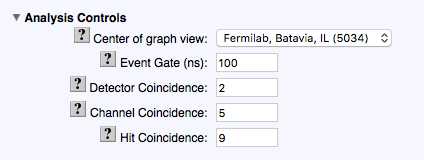|
|
||
|
Showers can pepper a large area of Earth's surface in a very tiny window of time. With the GPS device connected to the DAQ board, the absolute time stamp allows a network of detectors (at the same site or at different schools) to study cosmic ray showers. Students can look for small showers over their own detectors, or collaborate with other schools in the area to look for larger showers. The online analysis tools of the e-Lab can check for multiple detectors firing in a href="javascript:glossary('coincidence',350)">coincidence. They also allow students to make predictions about the direction from which the shower (and thus the primary cosmic rays) originated. The many particles in a shower light up the detector's
photomultiplier tubes (PMT)
with many signals one after another.
Interesting showers have many particles and cover a large area.
We set up the detector with the counters unstacked, Coincidence Diagram 
For more background, see how the detector works. Shower Study Interface Here is how to set the Detector, Channel and Hit Coincidence levels when doing a shower study like the one described above. 
|
||

 .
Each counter is connected via a channel to the DAQ. See picture below for a sample setup:
.
Each counter is connected via a channel to the DAQ. See picture below for a sample setup: